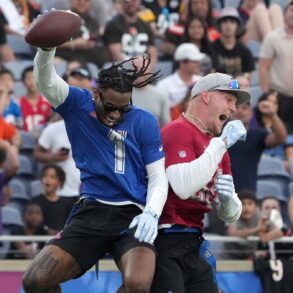
The NFL is going international, not just with its 2025 schedule, which includes a record seven different overseas contests played across five different countries, but with the 2028 Olympics. While the next Summer Games will be held stateside in Los Angeles, the NFL is officially set to partake in worldwide competition when flag football makes its anticipated Olympics debut.
NFL owners voted on Tuesday to allow player participation in the 2028 Summer Games, permitting up to one player per NFL team to represent America at the Olympics. It marks the latest chapter in an ongoing effort by the NFL to embrace and elevate flag football’s popularity, with league executive Troy Vincent declaring back in 2022 that the no-contact version of the sport is “the future of the game of football.”
NFL FLAG, the NFL’s official flag football program, deploys a standard 5-on-5 format, with each team fielding a 10-man roster comprised of the following positions:
Offense
- Quarterback, who can only run past the line of scrimmage after first handing the ball off and receiving a lateral or going out for a pass
- Center, who can go out for a pass immediately after snapping the ball
- Wide receiver/back, who can line up as either a standard running back or wide receiver
Defense
- Rusher, who can rush the quarterback from seven yards off the line of scrimmage
- Defensive back, who essentially functions as a traditional cornerback
- Safety, who prioritizes defending the pass over the run
And here are the flag football rules for the 2028 Olympics:
- Field is 70-by-25 yards
- 40-minute games: Two 20-minute halves (including 2-minute warning)
- Four downs to reach midfield and four downs to score touchdown
- No run plays within 5 yards of end zone
- Overtime if score is tied with each team getting equal chance to win
With this in mind, what might the NFL’s actual Olympic roster look like? We combed through the best of the league’s current talent, considering today’s stars will be three years older by the time the Summer Games kick off in July 2028, to identify one of the best possible 10-man rosters for international competition:
Proposed 2028 Olympics roster
Also considered: Ravens QB Lamar Jackson, 49ers QB Brock Purdy, Bears QB Caleb Williams, Falcons RB Bijan Robinson, Raiders RB Ashton Jeanty, Buccaneers RB Bucky Irving, Steelers WR DK Metcalf, Giants WR Malik Nabers, Rams WR Puka Nacua, Lions WR Jameson Williams, Chiefs WR Xavier Worthy, Raiders TE Brock Bowers, Bears TE Colston Loveland, Giants OLB Abdul Carter, Falcons OLB James Pearce Jr., Broncos CB Patrick Surtain II, Eagles CB Quinyon Mitchell
What’s the common thread for our selections? Speed. Athleticism. Multipurpose potential. Whereas traditional football still values tenacious blocking and defensive physicality (see: the Philadelphia Eagles’ dominant Super Bowl LIX win over the Kansas City Chiefs), flag football is all about open-field dynamism. You need players with sure hands and other fundamentals, yes, but burst and elusiveness are paramount.
It’s why, at quarterback, we prioritized a true dual threats, with Daniels arguably best positioned to offer the best of both worlds — tightrope accuracy, downfield touch and effortless mobility — in three years’ time. The running backs — Achane and Gibbs — are equally versatile, registering best as high-speed weapons in space, including as receivers out of the backfield. The top receivers may be a touch older come 2028, with Chase and Jefferson already well-established in the NFL, but their unmatched playmaking could make them two-way stars a la Hunter, who enters the league in 2025 as a potential multi-position force.
The defensive selections also prioritized athleticism. Whereas some of the NFL’s top defenders, like Pittsburgh Steelers edge rusher T.J. Watt, feast in part because of their physical strength, our picks — like Nolan Smith off the edge and incoming Bills rookie Maxwell Hairston — entered the league with near-record-breaking speed and explosiveness. Their ability to fly around the field could translate seamlessly to flag football, where keeping pace with another high-energy unit is key.
This post was originally published on this site be sure to check out more of their content.







